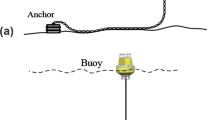Abstract
Floating production assets rely on mooring chain integrity to ensure safe operation. The offshore industry has identified a number of technical gaps in the industry’s knowledge on mooring chain integrity. This has limited the ability of designers and operators to reliably estimate the degradation of the mooring chain and to mitigate the risk of mooring line failures. The current code of practice recommends designing mooring systems based on uniform corrosion and factoring in a concurrent allowance for wear. A steel mooring chain retrieved from service exhibited both uniform and localized corrosion as well as wear damage. Pre-emptive chain replacements may be required if the observed degradation exceeds design expectations; such replacements can bear significant cost. Carbon steel is conventionally employed for mooring chains, however, there are significant incentives to explore new materials technologies with improved seawater corrosion and wear performance for mooring chain applications.
High Manganese Steel (HMS) can offer improved properties over conventional carbon steel and is a potential candidate for use as a mooring chain. In this contribution, several HMS chemistries have been assessed on various parameters of mooring chain performance, such as manufacturing, weldability of small scale bars, mechanical properties, and coupon fatigue testing. This contribution aims to present the results which indicate the potential of HMS as mooring chain material.
Zusammenfassung
Schwimmende Produktionsanlagen sind auf die Integrität der Verankerungsketten angewiesen, um einen sicheren Betrieb zu gewährleisten. Die Offshore-Industrie hat eine Reihe von technischen Lücken im Wissen über die Integrität von Verankerungsketten festgestellt. Dies hat die Fähigkeit von Konstrukteuren und Betreibern eingeschränkt, die Abnutzung der Verankerungskette zuverlässig abzuschätzen und das Risiko von Verankerungsleitungsausfällen zu mindern. Das derzeitige Regelwerk empfiehlt, Verankerungssysteme auf der Grundlage gleichmäßiger Korrosion zu entwerfen und eine gleichzeitige Abnutzung einzuplanen. Eine ausgemusterte Verankerungskette aus Stahl wies sowohl gleichmäßige als auch örtlich begrenzte Korrosion sowie Verschleißschäden auf. Ein vorbeugender Austausch der Kette kann erforderlich sein, wenn die beobachtete Abnutzung die Erwartungen an die Konstruktion übersteigt; ein solcher Austausch kann erhebliche Kosten verursachen. Für Verankerungsketten wird üblicherweise Kohlenstoffstahl verwendet. Es besteht jedoch ein erheblicher Anreiz, neue Werkstofftechnologien mit verbesserter Korrosions- und Verschleißleistung im Meerwasser für Verankerungskettenanwendungen zu erforschen.
Hochmanganstahl (HMS) bietet bessere Eigenschaften als herkömmlicher Kohlenstoffstahl und ist ein potenzieller Kandidat für den Einsatz als Verankerungskette. In diesem Beitrag wurden verschiedene HMS-Chemien auf verschiedene Leistungsparameter von Verankerungsketten hin untersucht, wie z. B. Herstellung, Schweißbarkeit kleiner Stäbe, mechanische Eigenschaften und Ermüdungstests an Bauteilen. Ziel dieses Beitrags ist es, die Ergebnisse zu präsentieren, die das Potenzial von HMS als Verankerungskettenmaterial aufzeigen.



Similar content being viewed by others
References
Bhattacharjee, S., Angevine, D., Majhi, S., Smith, D.: Permanent mooring reliability & mooring risk management plan (MRMP): a practical strategy to manage operational risk,” OTC-25841 (2015)
Crapps, J., He, H., Baker, D., Bhattacharjee, S., Majhi, S.: Strength assessment of degraded mooring chains. OTC-27549. (2017)
Consulting Report, A.B.S.: Study on mooring system integrity management for floating structures (2015)
Fontaine, E., Potts, A., Ma, K., Arredondo, A., Melchers, R.: SCORCH JIP: examination and testing of severely-corroded mooring chains from west Africa. OTC-23012. (2012)
Yue, X., Wasson, A.J., Anderson, T.D.: Welding technology development for an erosion-resistant slurry pipeline steel. Welding J 97(08), 229s (2018)
Verma, N., Wasson, A., Li, Z., Sidhar, H., He, H., Jin, H., Ozekcin, A., Ling, S.: New material development for offshore mooring chain—high manganese steel. OMAE2019-95541. (2019)
Verma, N., Wasson, A., Li, Z., Sidhar, H., Yue, X., He, H., Jin, H., Ling, S., Jun, H., Ozekcin, A.: High manganese steel technology for mooring chains application. OTC-29246. (2019)
ASTM E466-15, Standard Practice for Conducting Force Controlled Constant Amplitude Axial Fatigue Tests of Metallic Materials, ASTM International, West Conshohocken, PA, 2015
ASTM E8 / E8M-16a, Standard Test Methods for Tension Testing of Metallic Materials, ASTM International, West Conshohocken, PA, 2016
Author information
Authors and Affiliations
Corresponding author
Additional information
Publisher’s Note
Springer Nature remains neutral with regard to jurisdictional claims in published maps and institutional affiliations.
Rights and permissions
About this article
Cite this article
Sidhar, H., Fenske, J.A., Xu, W. et al. High Manganese Steel for Mooring Chain Applications. Berg Huettenmaenn Monatsh 167, 530–533 (2022). https://doi.org/10.1007/s00501-022-01287-3
Received:
Accepted:
Published:
Issue Date:
DOI: https://doi.org/10.1007/s00501-022-01287-3




